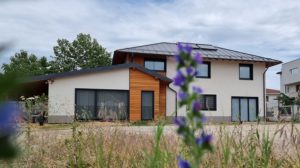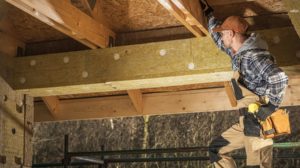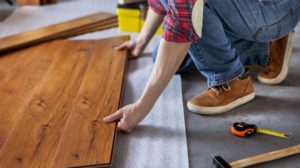House between the apple trees has reached the installation phase of underfloor heating. The team of carpenters from Litarh has completed its work, virtually completing the project in terms of structure and all the builder's tasks. Now it was the turn of the installers. The actual construction took a month and a half, with the rest of the time needed for design, approvals, foundation, installation and finishing. During this phase of the construction we spoke to Cristian Tănase, who is in charge of all the heating installation, including the installation of the underfloor heating. You can watch the episode at the end of the article. But until then, a few thoughts on the efficiency of underfloor heating. There are voices that say it is not recommended to choose wood when having this type of heating because it is good insulator and makes the system inefficient. Let's see what the experts say about wood and underfloor heating.
Heat resistance of wood flooring
Heat resistance is the main factor influencing the efficiency of underfloor heating. It affects the heat transfer from the installation to the room. Lower heat resistance means shorter heating time. Wood has a higher resistance to heat transfer, which means an increase in the time the room heats up. But the same resistance to heat means that when the installation is switched off, the heat persists longer. Wood also accumulates heat energy and releases it gradually compared to other materials, contributing to long-lasting warmth.
Heat resistance is directly proportional to the thickness of the material, being lower if the material is thinner. On the other hand, the thermal conductivity of wood increases with its density. So, for efficient heat transfer, the wood floor must be thin and dense. The thicker the floor, the lower the efficiency and the higher the energy consumption. The heat resistance of the floor should not be higher than 0.14 m²K/W. As each layer has its own heat resistance, it is recommended not to lay carpet on top of the wooden floor because it will lead to lower heating efficiency.
Factors on which the efficiency of underfloor heating depends
Wood's resistance to heat transfer is not the only problem with underfloor heating. Its dimensional variation with humidity variation can be another problem. This can mean shrinkage with the appearance of gaps between elements, expansion (the floor swells) and deformation (twisting, bending). All of these must be taken into account when installing heating systems under a wooden floor.
In order not to have any surprises, the wood must be heated evenly, therefore the heating must be installed evenly under the entire floor. The installation must be carried out on the basis of a project drawn up by a specialist who will also make recommendations on the type of flooring and positioning of furniture. The furniture should also have legs so that air can circulate underneath it.
The parameters under which the installation operates must be rigorously controlled.The temperature under the wooden floor must not exceed 27ºC. In this case the temperature on the floor surface will reach 23-24ºC and the temperature in the room 21-22ºC. To maintain this level, the house must be properly insulated. If a higher temperature is desired, underfloor heating will have to be doubled by another heating option. The most efficient underfloor heating is with ceramic (tiles) or stone.
The thickness of the wood must not exceed 18 mm.Thicker wood will act as an insulator and heating will not be more efficient. The highest efficiency is given by a 14-16 mm thick floor.
The wood must be adequately dry and its moisture content in the range 8-10%. Dried wood performs best in professional dryers that follow controlled drying cycles.
Types of wood flooring suitable for underfloor heating system
Wood is a natural material that 'works'. Rising temperatures can lead to warping and even cracking of wood flooring. But not all species react in the same way. Maple and fagul are prone to deformation, while oak tree, bamboo, cherry deforms much less. Deformation is excluded in layered materials. Deformation and movement of wood also have an effect on the finish. Varnish film applied to solid wood flooring is more likely to crack than that on laminate flooring. The risk is eliminated by using oil or wax-based finishes.
Laminated wood flooring. It is the one recommended by specialists for such heating because it is very stable, adapting to changes in humidity. Laminated wood is actually plywood or MDF veneered with thick veneer (blind) of a wood suitable for parquet (oak, ash). Plywood can be made from the same or a lower species. The most suitable for underfloor heating is plywood made from new, softwoods (resinous, poplar) because heat passes through them easily.
Solid wood flooring. Long wooden elements behave differently depending on the class they belong to. Hardwood with high density is not recommended for this type of heating. Its dimensional variation is large and it can warp or crack. This is the case for beech or maple wood. Soft, loose wood such as softwood is not recommended because it traps heat instead of transferring it. Always seek specialist advice as defects can occur. The thickness of the elements is also very important.
Parchet. This category includes small floor elements. Both hardwood and softwood can be used. It is possible that dimensional variation may result in gaps between elements. This is remedied by repositioning the elements and filling the gap with new elements. The best species are considered to be oak and nuc.
Bamboo flooring. Bamboo is increasingly used for flooring. It is twice as hard as oak and performs well in underfloor heating.
Laminate flooring. In this case it is not wood. Laminate flooring is layers of resins, and the surface is an imitation of the appearance of wood. Laminate flooring has good thermal conductivity due to its thickness and high density and is an affordable option for underfloor heating.
Before fitting wood over underfloor heating, seek specialist advice. You will avoid a lot of inconvenience.



























Add comment